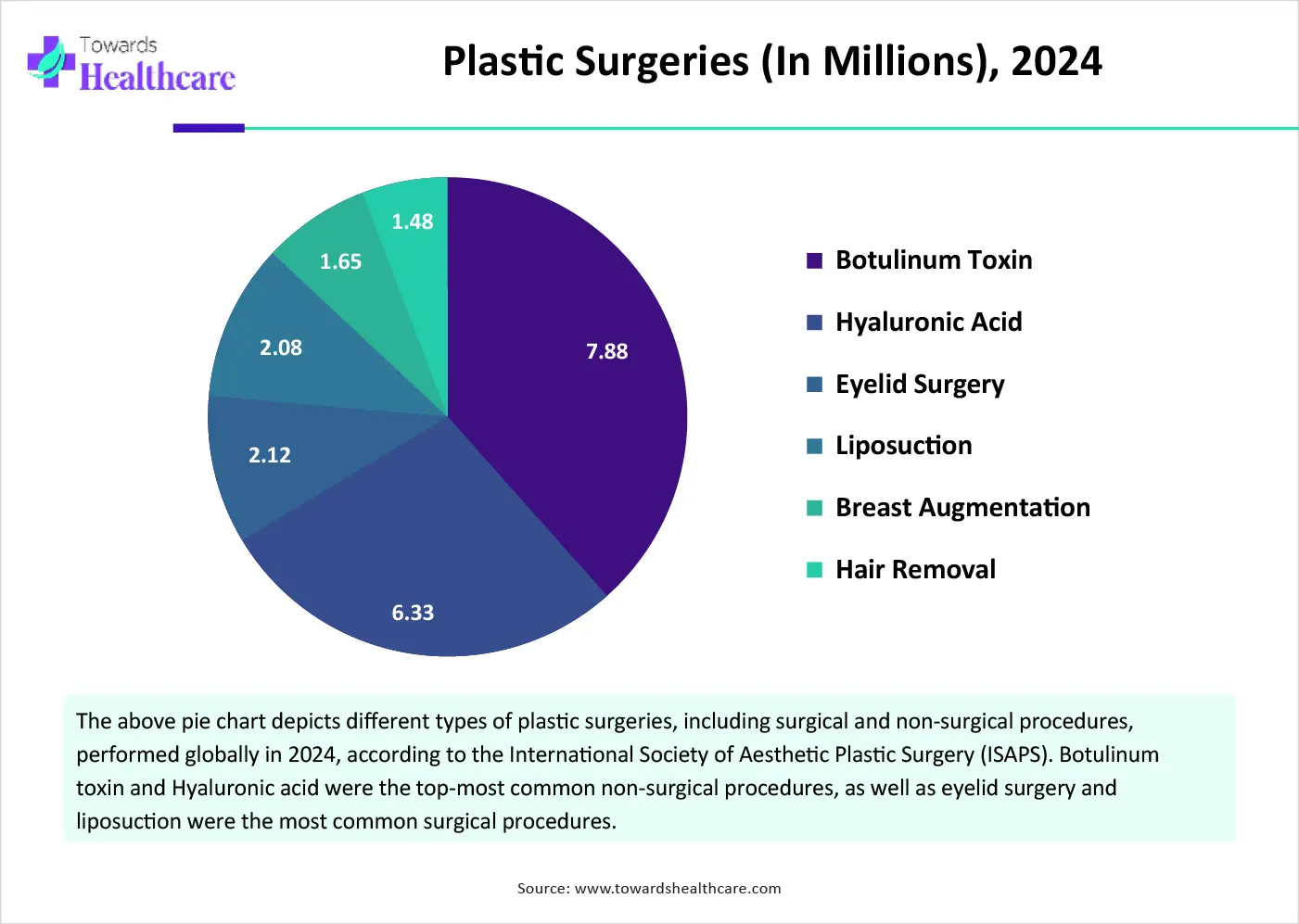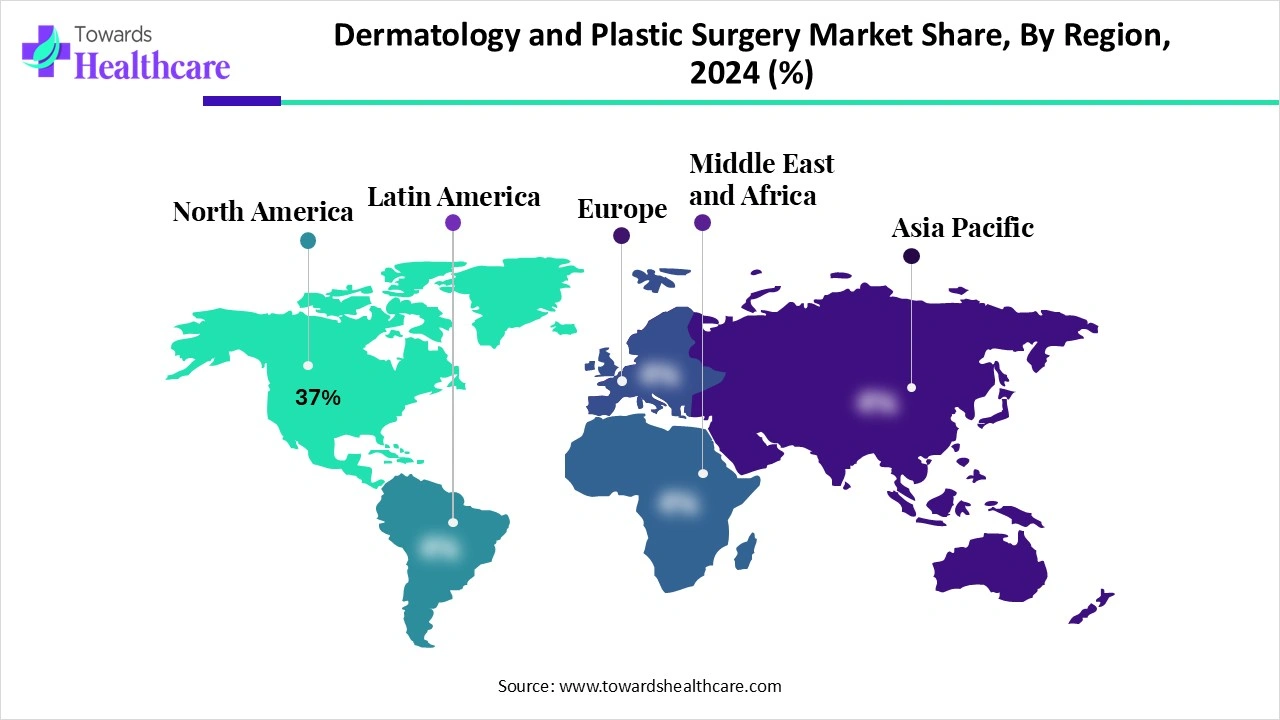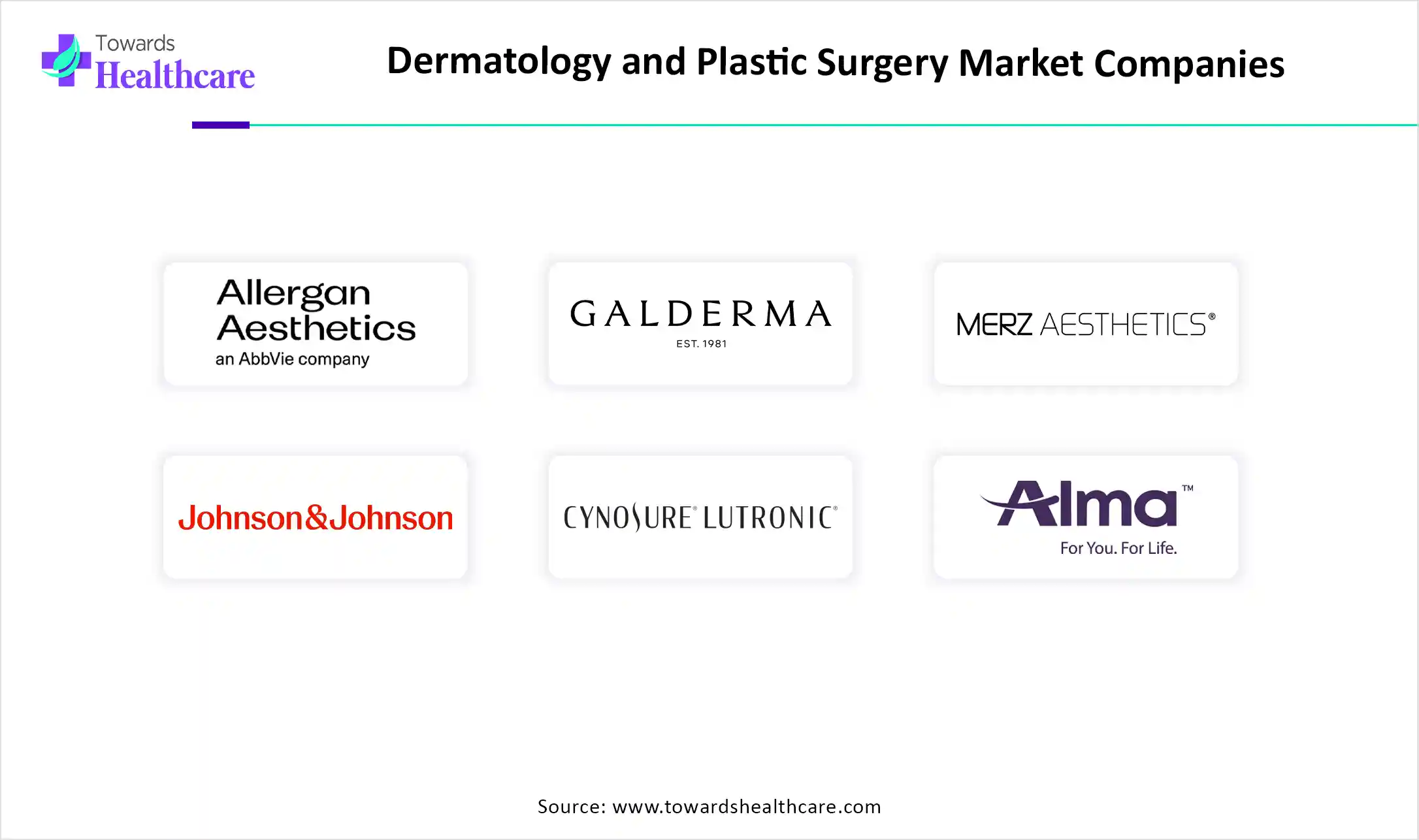December 2025

The global dermatology and plastic surgery market is on an upward trajectory, poised to generate substantial revenue growth, potentially climbing into the hundreds of millions over the forecast years from 2025 to 2034. This surge is attributed to evolving consumer preferences and technological advancements reshaping the industry.
The dermatology and plastic surgery market is primarily driven by the rising prevalence of skin disorders and the growing geriatric population. People are becoming increasingly aware of minimally invasive surgeries, which offer faster recovery times. The burgeoning medical tourism sector in emerging countries facilitates market growth. The future looks promising, with technological advancements in surgical procedures.
The market encompasses medical and aesthetic procedures focused on treating, enhancing, and restoring skin, hair, nails, and other body parts. Dermatology addresses medical conditions, such as acne, psoriasis, and skin cancer, while plastic surgery covers both cosmetic (e.g., rhinoplasty, liposuction) and reconstructive (e.g., trauma repair, burn treatment) procedures. The convergence of advanced medical devices, biologics, and energy-based technologies alongside rising aesthetic consciousness, aging population, and demand for minimally invasive solutions is fueling this dual-specialty market.

Artificial intelligence (AI) has been found to play a crucial role in dermatology by screening and assessing skin disorders. It can analyze skin type and conditions, as well as suggest recommendations for personalized skin treatment. AI and machine learning (ML) algorithms can track and identify skin lesions, providing real-time data to physicians. This helps them to make proactive decisions and provide necessary treatment. In addition, integrating AI in plastic surgery is beneficial due to robotic assistance and predictive analytics. Robotic surgery simplifies the task of surgeons and reduces manual errors. It reduces the total time required for surgery and improves patient outcomes.
Demand for Minimally Invasive Surgeries
The major growth factor of the dermatology and plastic surgery market is the growing demand for minimally invasive surgery (MIS). MIS usually involves accessing the organ through small incisions, thereby minimizing patient trauma, scarring, and recovery times. The demand for MIS is increasing due to its ability to address various skin conditions and aesthetic concerns. Laparoscopic, arthroscopic, and robotic surgeries are common examples of MIS. Scientists have also developed non-invasive surgeries that offer superior benefits over traditional surgical procedures, reducing discomfort and improving treatment outcomes.
Complications
Patients undergoing dermatology and plastic surgery face numerous complications, including infection and nerve damage. They may also face changes in skin color, scarring, and persistent swelling. Recent research has found that such complications may lead to depression, anxiety, and other mental health disorders, posing a significant barrier to dermatology and plastic surgery treatments.
What is the Future of the Dermatology and Plastic Surgery Market?
The market future is promising, driven by the use of virtual reality (VR), augmented reality (AR), and mixed reality (MR). These technologies enable a real-time, immersive, and interactive experience using special equipment. They reduce geographical barriers and connect different surgeons, as well as surgeons with patients. The immersive experience between surgeons and patients optimizes the shared decision-making process and provides a realistic physician-patient experience. VR, AR, and MR also enable the sharing and training of techniques used for surgery or cosmetic dermatology, including simulation of flap design, Botox/dermal filler injection, and laser procedures.
By specialty area, the cosmetic dermatology & aesthetic surgery segment held a dominant presence in the market in 2024. This is due to the growing demand for aesthetic appearance, which leads to enhanced confidence. The increasing geriatric population potentiates the demand for anti-aging treatments. This helps people look youthful, thereby leading to greater satisfaction and psychological impacts. Technological advancements, such as laser-based technology, have revolutionized cosmetic dermatology and aesthetic surgery.
By specialty area, the reconstructive plastic surgery segment is expected to grow at the fastest CAGR in the market during the forecast period. The rising prevalence of skin disorders, such as burns, scars, and trauma, necessitates reconstructive plastic surgery. According to the American Burn Association, one person per 10,000 people is estimated to require inpatient hospitalization at a burn center in the U.S. (Source - Ameriburn). Reconstructive surgeries correct defects that enable people to lead a normal life and improve their well-being.
By procedure type, the non-invasive procedures segment held the largest revenue share of the market in 2024. This segment dominated because non-invasive procedures can diagnose, measure, monitor, or treat problems without incisions. Patients prefer non-invasive procedures as they do not cause any post-surgical complications. Moreover, such types of procedures can be performed on any patient, irrespective of their age, mental status, and other health conditions. Patients also do not need to stay in the hospital after surgery, saving healthcare costs.
By procedure type, the minimally invasive procedures segment is expected to grow with the highest CAGR in the market during the studied years. Minimally invasive procedures offer numerous benefits, such as faster recovery time, cost-effectiveness, and lower risk of complications. Cutting-edge technologies have potentiated the demand for such procedures, improving patient outcomes. These procedures offer excellent aesthetic results and increase patient satisfaction rates.
By technology, the injectables segment contributed the biggest revenue share of the market in 2024. This is due to the cost-effectiveness of injectables and minimally invasive or non-invasive procedures. Injections are easy to administer, have long-lasting effects, and can be taken by people of any age from 20 to 70 years. They are mostly preferred for anti-aging procedures. They are used to correct mimetic wrinkles caused by the movement of facial muscles over time.
By technology, the ultrasound & radiofrequency-based devices segment is expected to expand rapidly in the market in the coming years. Technological advancements have led to the development of innovative ultrasound and radiofrequency-based devices. These devices offer non-invasive benefits for various dermatology procedures. They are mostly used for skin tightening, tissue sculpting, and surgical guidance. Radiofrequency is effective for a wide range of patients, including those with darker skin who may experience discoloration with a laser.
By end-user, the specialty dermatology & aesthetic clinics segment led the global market in 2024. The segmental growth is attributed to the availability of specialized equipment and the presence of skilled professionals. The increasing number of clinics due to the growing demand for aesthetic procedures boosts the segment’s growth. These clinics provide personalized treatment to patients before, during, and after surgery. Patients also prefer these clinics due to favorable reimbursement policies.
By end-user, the ambulatory surgical centers (ASCs) segment is expected to witness the fastest growth in the market over the forecast period. ASCs have suitable capital investments to adopt advanced surgical instruments. They enhance clinical productivity and improve patient satisfaction. They enable a same-day surgery and discharge policy, eliminating the need for a patient to stay overnight in ASCs.

North America dominated the global market share by 37% in 2024. The availability of a robust healthcare infrastructure, the growing geriatric population, and technological advancements are the major growth factors of the market in North America. The presence of key players and the increasing number of cosmetic surgeries favor market growth. Some government and private organizations also support the market by reimbursing the cost of surgeries.
According to the American Society of Plastic Surgeons, more than 1.5 million plastic surgeries were performed in 2024. Liposuction, breast augmentation, abdominoplasty, breast lift, and blepharoplasty were the top five most common cosmetic procedures. (Source - Plastic Surgery) Key players, such as Allergan Aesthetics, Cutera, Inc., and Revance Aesthetics, are the major contributors to the market in the U.S.
Canada has around 500 plastic surgeons. The Canadian Dermatology Foundation supports dermatology research in Canada by providing over $10 million in 2024. The Canadian Dermatology Association (CDA) reported that approximately 20% of Canadians live with acne, over 1 million have psoriasis, and nearly 2 million have rosacea. (Source - Canadian Dermatology Foundation)
Asia-Pacific is expected to grow at the fastest CAGR in the dermatology and plastic surgery market during the forecast period. The increasing demand for aesthetic appearance and the burgeoning medical tourism sector boost the market. Countries like South Korea, India, China, and Japan are at the forefront of providing state-of-the-art dermatology care and plastic surgery treatment. The rising prevalence of skin disorders and skin cancer necessitates that patients undergo advanced therapies. The growing demand for minimally invasive surgeries also fosters market growth.
South Korea is often regarded as the cosmetic surgery capital of the world. In 2024, 1.17 million people from 202 foreign nations visited Korea for medical services. Since 2009, a total of 5.05 million patients have visited Korea, of whom 23% visitors were for dermatology and 12% for plastic surgery. (Source - Medical Korea)
Japan conducted a total of 1.63 million plastic surgeries in 2024. There are over 4,000 plastic surgeons across Japan, providing state-of-the-art care. Additionally, Japan’s cities are seeing a sharp rise of 44% in cosmetic surgery clinics. As of 2023, there were more than 2,000 cosmetic clinics in Japan. The number of plastic surgery clinics increased by 15% between 2020 and 2023.
Europe is expected to grow at a notable CAGR in the dermatology and plastic surgery market in the foreseeable future. Favorable government support and growing awareness about plastic surgeries and aesthetic appearance drive the market. Government and private organizations conduct conferences, seminars, and workshops to train individuals and raise awareness of cutting-edge technologies. The rising adoption of advanced technologies and increasing investments and collaborations propel market growth.
Germany conducted more than 1.3 million plastic surgeries in 2024, with the highest number of injectables and face & head surgeries. Germany will host the “International Conference on Plastic and Cosmetic Surgery 2025” in November 2025. The conference aims to reconcile scientists, academicians, and industry professionals and share updates related to the field.
France is set to host the “Dermatology and Plastic Surgery World Conference (DPSWC) 2025 in October 2025. The three-day conference will include global perspectives on trends, practices, and innovations in dermatology and plastic surgery. (Source - Dermatology and Plastic Surgery World Conference)

Dr. Ben Aldridge, Founder of Waterfront Private Hospital, commented that the team focuses on combining a dual approach, i.e., dermatology and plastic surgery expertise in a single consultation, saving patients multiple visits. They provide the fastest and most efficient private skin cancer service in Scotland. They aim to provide private skin cancer treatment, making a tangible difference to patients’ lives.
By Specialty Area
By Procedure Type
By Technology
By End-User
By Region
December 2025
December 2025
November 2025
November 2025